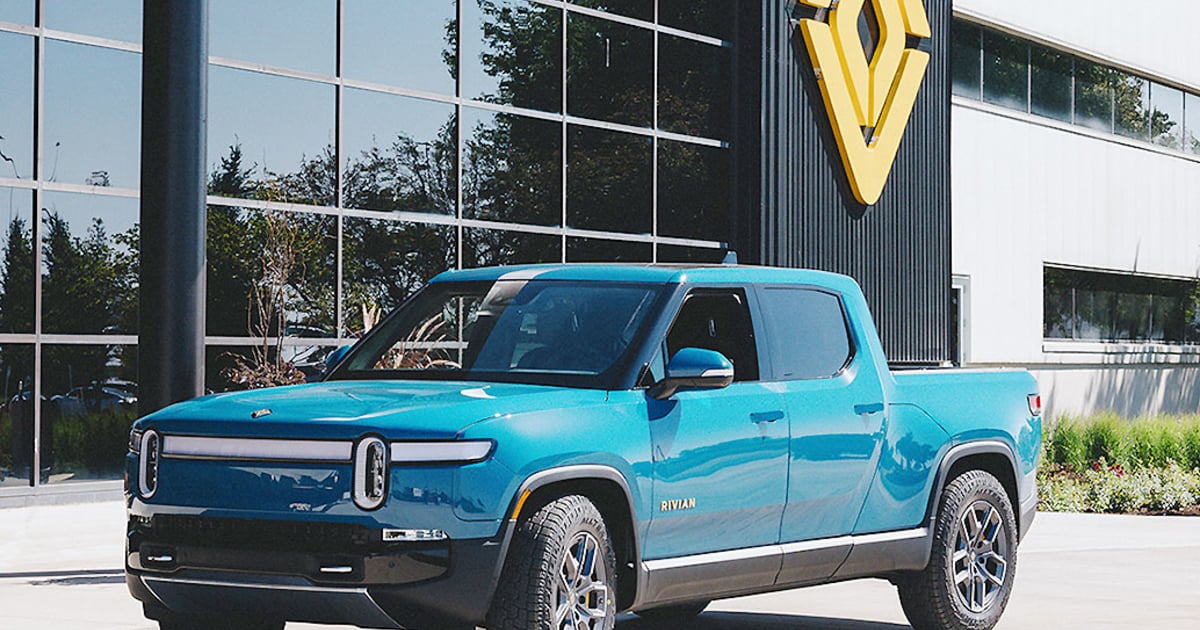
Rivian is gearing up to expand production of its electric vehicles and significantly reduce costs over the course of the year, but Tuesday’s first-quarter earnings report will reflect reduced sales stemming from factory downtime.
The automaker produced and delivered fewer vehicles in the January-March period than the previous quarter. It reported 7,946 deliveries in the first-quarter compared with 8,054 in fourth-quarter 2022.
Rivian executives previously warned that an upgrade of its commercial van assembly line would reduce output temporarily to add its new in-house Enduro motor and a less expensive iron-phosphate battery pack.
“Production levels were low — and expected to be low — in that Q1 time frame,” Rivian CFO Claire McDonough said at an investor conference in early April. The vans are built under contract for Amazon.
The production changes will lower costs over time and find their way this year to the assembly line that makes the R1T pickup and R1S crossover, McDonough said. Having an in-house motor in addition to a third-party motor will also ease supply-chain issues that have constrained production, she said.
Rivian is likely to post a net loss moderately smaller that the $1.7 billion it reported in the fourth quarter, Zacks Investment Research said in a May 1 note. Revenue is expected at $686 million versus $663 million in the previous quarter, Zacks said, citing the market consensus from analysts.
The automaker launched the R1T in late 2021 and the R1S last year. Its production ramp-up at its Normal, Ill., plant has been significantly slower than originally forecast.
Rivian expects to make 50,000 vehicles this year but did not break down that number by model. In 2022, Rivian reported production of 24,337 and deliveries of 20,332.
Cox Automotive estimated that Rivian delivered 6,213 R1T pickups in the first quarter and 552 R1S crossovers. In the year-earlier period, the automaker delivered an estimated 1,164 of the R1T and 50 of the R1S. Cox did not estimate commercial van deliveries.
While Rivian is running behind the pace it needs to meet its 2023 production estimate, the company says it’s laying the groundwork for better numbers for the rest of the year.
In a May 1 shareholder letter, CEO RJ Scaringe said the EV maker has produced about 35,000 vehicles since the start of production, including the R1T, R1S and two sizes of vans for Amazon, the EDV500 and EDV700.
“Our 2023 production guidance of 50,000 vehicles remains on track, representing a 100 percent increase from 2022,” Scaringe said in the letter. “We have deepened and extended our relationships with key suppliers to support our ramp.”
The automaker is also working on its next vehicle platform, called R2, which is being designed for more inexpensive models. Rivian is building a plant in Georgia to make R2 vehicles starting in 2026. The company’s most inexpensive vehicle currently is the base R1T at $74,800 with shipping.
“Built from the ground up, our Georgia plant will leverage all the learnings from our Normal, Illinois, campus and is expected to have 400,000 units of annual production once it’s operating at full capacity,” Scaringe said in the shareholder letter.
Some financial analysts have questioned whether Rivian will have enough cash to fund the new plant and its production ramp-up, unless it sharply brings down costs. The company reported a net loss of $6.75 billion for full-year 2022.
Rivian announced job cuts in February totaling 6 percent of its work force, or about 840 people. It also cut jobs in July 2022.
Rivian shares rose 3.6 percent on Friday, May 5, to close at $13.41. That’s down almost 90 percent from its first day of trading in late 2021.
The EV startup’s manufacturing bottlenecks and financial pain contrast with a string of industry accolades for its products.
In early May, the Insurance Institute for Highway Safety named the R1S as a top safety performer for the 2023 model year. The R1T had already received the designation, formally called Top Safety Pick Plus.
In February, the R1T earned the top J.D. Power award for satisfaction among owners of premium battery electric vehicles. Factors considered for the award include styling, safety, service and driving enjoyment.

